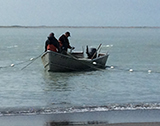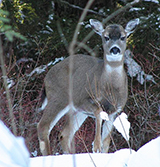Alaska Fish & Wildlife News
December 2016
Bear Rub Trees and Scent Marking

The big bear padded up to the base of the tree and carefully smelled the bark. He stood and sniffed higher up, giving it a thorough inspection. He dropped back to all fours and rubbed his head, neck and flanks against the tree, then stood and rubbed his back, right between his shoulder blades. He wasn’t scratching an itch; he was marking, leaving his own scent on the tree.
There are trees like this all over Alaska. Rub trees – bear sign posts. Most are scratched, bitten and ... Bear Rub Trees Article Continued
Researching the Customary and Traditional
Uses of Wild Resources by Alaskans

For nearly 40 years, the Division of Subsistence has been researching the customary and traditional uses of wild resources by Alaska residents. As Division researchers, we rely heavily on social science research methods to carry out our mission of gathering, quantifying, evaluating, and reporting information about customary and traditional uses of Alaska’s fish and wildlife resources. We spend time in communities, learning about their harvest and use practices, getting to know their perspectives ... Using Wild Resources Article Continued
Sharing the Harvest

Southeast Alaska provides year round harvest opportunities. Deer and moose hunting in the fall, trapping in the winter, hooter hunting in the spring, and fishing in the summer. Spring and summer are fiddlehead, berry and mushroom picking time, too, along with all the beach greens. If you accept rain as something to embrace, you’ll love it here. Southeast Alaska's wild resources are so abundant they provide a surplus that allows those who can harvest to share with those who can’t. ... Sharing the Harvest Article Continued
Science Takes Time: Rock Ptarmigan Research

Most Alaskans are familiar with ptarmigan and many have enjoyed their “clowns of the tundra” antics in the spring. These birds may be well-known, but they are poorly understood.
Learning about the biological world through the scientific method requires patience and time. However, if planned appropriately from the start, the process can yield surprising nuggets of knowledge. This is particularly true in areas where no strong prior understanding existed. Now let’s not kid ... Rock Ptarmigan Study Article Continued
